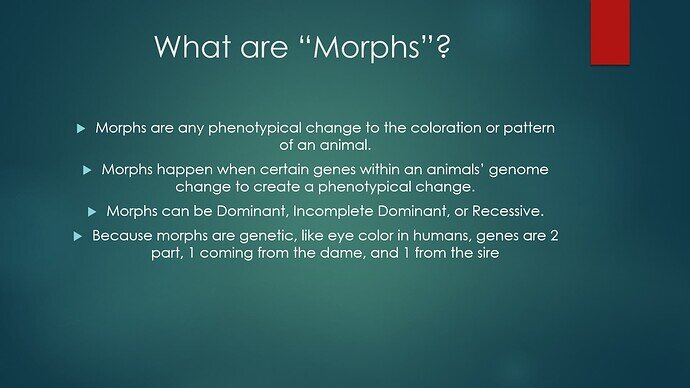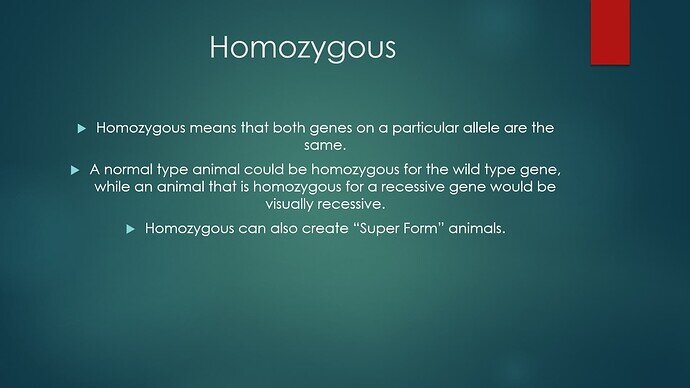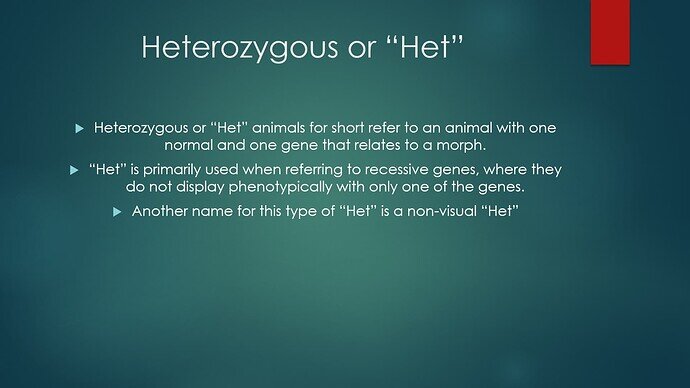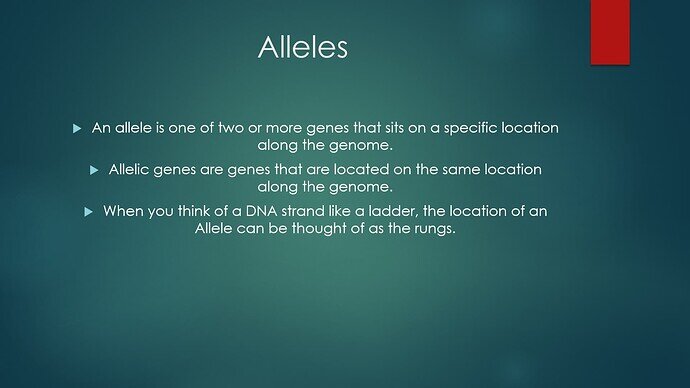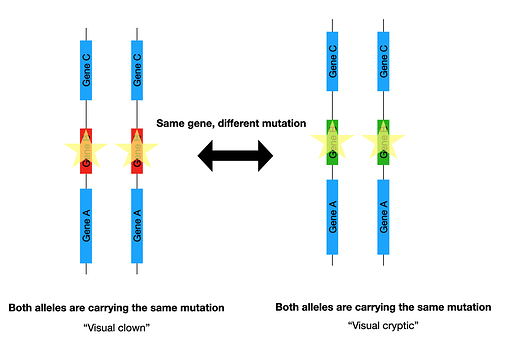Hey all, I had to create a informative speech for my public speaking class and chose to do one on ball python genetics. I figured I would share it here as well as I know there are frequently questions about it. I tried to keep things as simple as possible, so it may not be 100% accurate (such as using eye color as an example of dominant and recessive despite eye color in humans being affected by 3 separate genes)
If anyone has any suggested changes I could definitely fix it up to make it more accurate so as to be more useful to people reading it. I used my own snakes as visual examples during the presentation, so unfortunately I didn’t include any pictures during the class, but with Morphedia, I’m sure they can find examples easily enough once they know what the terms mean!
I’m sure @t_h_wyman could correct the disaster I’m sure the last page is for me XD This is all going off my own understanding, so I’m sure I’ve made a mistake or two =)
8 Likes
A few things that jumped out at me from first pass (pardon any typos/confusion, I’m super tired):
-
Alleles are not the “rungs on the ladder”, if you’re viewing DNA like a ladder, the “rungs” would actually be the base pairs (A, T, G & C) and the hydrogen bonds between them.
-
Heterozygous does not refer to an animal with one normal and one morph at the same locus, it simply refers to when an organism has two different alleles at the same locus (in ball pythons a bamboo butter would be heterozygous at the BEL locus)
-
On your DNA slide, having the “genes” arrow facing the bottom of the DNA strand isn’t correct, it should be portrayed more like this…
Homozygous -
Heterozygous -
- The way the “Super Forms” slide is stated isn’t super correct. There aren’t two different incomplete dominant traits on the same allele, there are two different morph alleles at that locus/gene OR two of the same allele. A “complex” is what we call a group of allelic morphs
6 Likes
Gotcha, i knew that wasnt super correct. I know alleles were locatio. Oriented, but didnt have a good way to express that. I think i lacked proper terminology for it, and i definitely skipped over chromosomes and smaller bits for simplicity. I put genes where i did to show it represented the 2 pairs within the sequence all the way up as all being genes, i put allele where i did to show it was a specific location along the strand. Ill definitely see if i cant edit it with better terminology.
I also didnt intend for it to come off as “supers” had to be different genes, i had meant it to mean any set of 2 inc dom genes that are allelic to eachother should be able to create a super form, and that allelic inc dom gense that functioned in this way were called a complex, it wasnt meant to exclude the possibility of 2 identical inc dom genes forming a super.
I appreciate the feedback! Locus was definitely the word i needed to represent the location of the genes along the strand!
3 Likes
Also, i would argue crypton isnt a super form, crypton is formed with 2 recessive genes that are alleleic to eachother. A super so far as i know is the true form of an incomplete dominant trait when homozygous. That being said, alot of super forms (like BEL) dont need a homozygous form, but rather that allelic genes at a locus are present.
When its 2 recessive genes that are allelic, it is more if a half display of both recessives, rather than a true form. Like both halfs together make something the whole of either could not make.
I could be wrong, but i believe its different than a super.
3 Likes
As a 3rd note, i think i see what you mean, the alleles are located on the chromosomes, not on the dna strand, so the location analogy is correct, but not the ladder analogy, as it isnt a rung, but rather a section of the rung. I still understood how it worked in function the way i thought of it, but you are right, it is definitely not an accurate diagram, i will need to modify later and reupload a better representation that more accurately shows what is where
3 Likes
Not sure “disaster” is the term I would use LOL
- “Paradoxing” is an illegitimate term in the hobby used to describe animals that are Mosaics or Chimeras
- A Mosaic is two (or more) genotypes present but they derive from the same source, i.e., all cells are derived from a single embryo
- A Chimera is two (very rarely more) genotypes present derived from different sources, e.g., twin fusion (there are less common forms as well)
- Chimerism and Mosaicism both happen in humans.
7 Likes
Gotcha! So i actually wasnt too far off haha, the only reason i even brought up mosaicism is because i had a conversation with you previously where you had explained the concept haha.
3 Likes
I wasn’t using those graphs to argue that Crypton was a super form, they were just to illustrate how to better represent genes/alleles on a powerpoint. I already had that slide made up to explain something to someone at some other point and just grabbed a screenshot
5 Likes
Compound heterozygous would be the term. Equally applicable to things like Freeway and Gargoyle and Potion
6 Likes
Gotcha! Yeah, i did some google searching after your post and found that allele locations were along the chromosomes and that chromosomes are made of DNA. So the concept is similar but it is at the chromosomal level, not the DNA level. Ill have to use all of my MS paint skills to fix that slide haha.
1 Like
The change of a single, solitary base (which is as DNA level as you can get) is sufficient to to generate an allele
5 Likes
I meant when demonstrating what an allele is. In my doaga i treated it as a location of a “rung” along a “ladder” which is inacurate, it is actually the location of a genetic sequence on the chromosome.
1 Like
Some of this you might of already corrected but I’ll bring up
Is blue eyes in humans a good example? I only ask because the last time I read about there was up to 4 different loci having an effect on eye color. Which if that’s correct would be a great example of polygenetic, answering questions like why is one pastel brighter than another.
“they are overpowered by other genes located on the same allele.”
They are overpowered by another allele. An allele is just a variation of the same gene.
“two recessives on the same allele”
two recessive at the same locus.
Locus is the location.
Genes are the things that sit there
Alleles are the same gene, just different
From what I’ve seen most people do not refer to compound heterozygous combos as supers like freeway and such. So i disagree with that whole concept. It also makes you 2nd bullet point contradict the 3rd bullet point on the slide, since they are not homozygous. But super is a hobby made term with a floating definition.
5 Likes
Last i checked it was 3, however the school systems dont teach this, they actually use it in most public schools to explain recessive and dominant genetics in US school systems. So while it isnt the most accurate example, it is the one most US residents would be able to relate to and help with learning (i dont know what other countries teach).
Since the guide is meant for the layman, i figured it was a simple enough explanation even if technically inaccurate.
1 Like
My understanding of this is alleles are different genes on the same locus. But it could be incorrect.
Edited, i didnt read this correctly. You are saying they arent refered to as supers, not that they arent compound hets. My bad haha
What i was refering in that slide was things like the BEL complex, but seeing what you guys are saying, i could agree that its more of a coincidence they all look roughly the same when combined. I know there are minor differences depending on which morphs are used for BELs, so in thay case its a subtle difference, but it is still different. A bambam BEL would be a super, but a Bam moja BEL would be a comound het. If im understanding you guys correctly
Good catch! I didnt notice that at all, but you are right.
I do plan to make edits and reupload, it was just finals week, so couldnt do right away haha
Same gene, that’s what makes them alleles. Like cinnamon and lesser are not alleles, lesser and mojave are, cinnamon and black pastel are.
3 Likes
You have me a bit confused here. It was my impression that mojave and lesser are different genes that simply share a locus and react with eachother when both present. Their appearance is very different. If they are the same gene but different morphs, then what is a morph? I thought a morph was just what hobbyists and breeders named genes.
The easiest example would be bamboo and mojave, they are 2 very distinct morphs from eachother, but because they are alleleic to eachother, they form a compound het. So far as i know, they are 2 different genes that share a locus.
Unfortunately you’ve stumbled upon one of the major issues with the ball python hobby, naming conventions haven’t always corresponded with actual genetics.
People use gene and morph interchangeably, when in reality morph = allele. Mojave and lesser are different alleles of the same gene, as are bamboo and mojave. Genes usually sit at a particular locus in the genome, barring various genetic rearrangements, which I am not getting into. A change in a single base pair in the DNA of that gene (such as C > T) can make it a completely new allele.
The definition of an “allele” if you look it up is “One of two or more alternative forms of a gene that arise by mutation and are found at the same place on a chromosome.”
3 Likes

